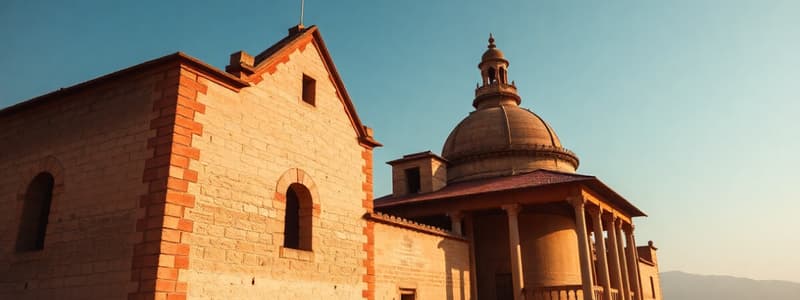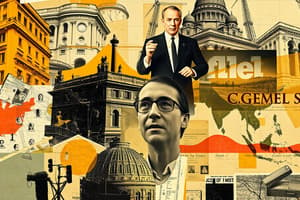Podcast
Questions and Answers
What significant development occurred within one hundred years after the advent of Islam?
What significant development occurred within one hundred years after the advent of Islam?
- Islamic state expanded to many countries. (correct)
- The Islamic state began trading exclusively with Europe.
- Muslim travelers solely focused on pilgrimage.
- Islam became the dominant religion in Asia only.
Which aspect was NOT a focus of the Muslims during the expansion of the Islamic state?
Which aspect was NOT a focus of the Muslims during the expansion of the Islamic state?
- Establishing military dominance.
- Isolation from other cultural influences. (correct)
- Cultural exchanges with locals.
- Trade with neighboring regions.
What was the timeframe for the expansion of the Islamic state after the founding of Islam?
What was the timeframe for the expansion of the Islamic state after the founding of Islam?
- Ten years.
- Two thousand years.
- Five hundred years.
- One hundred years. (correct)
What is considered a significant outcome of the expedition to Latin America?
What is considered a significant outcome of the expedition to Latin America?
What was one of the outcomes of the expansion of the Islamic state?
What was one of the outcomes of the expansion of the Islamic state?
Which aspect of geography was primarily influenced by the expedition to Latin America?
Which aspect of geography was primarily influenced by the expedition to Latin America?
Which consequence of the Islamic expansion is often highlighted?
Which consequence of the Islamic expansion is often highlighted?
What is the focus of the sciences that benefited from the Latin American expedition?
What is the focus of the sciences that benefited from the Latin American expedition?
Why might the expedition be seen as memorable?
Why might the expedition be seen as memorable?
Which scientific discipline was NOT directly impacted by the Latin American expedition?
Which scientific discipline was NOT directly impacted by the Latin American expedition?
Which regions did Strabo describe in his cultural geographies?
Which regions did Strabo describe in his cultural geographies?
What was the farthest east Strabo's cultural geography extended?
What was the farthest east Strabo's cultural geography extended?
Which of the following regions was not mentioned as part of Strabo's cultural geographies?
Which of the following regions was not mentioned as part of Strabo's cultural geographies?
What aspect of geography did Strabo primarily focus on in his writings?
What aspect of geography did Strabo primarily focus on in his writings?
Which northernmost region was included in Strabo's cultural geographic descriptions?
Which northernmost region was included in Strabo's cultural geographic descriptions?
What does the concept of regions primarily depend on?
What does the concept of regions primarily depend on?
Which of the following is NOT a typical characteristic used to define a region?
Which of the following is NOT a typical characteristic used to define a region?
How might individuals assess the type of region they live in?
How might individuals assess the type of region they live in?
In what way do mental maps contribute to the understanding of regions?
In what way do mental maps contribute to the understanding of regions?
What is a significant factor that might influence how one perceives their region?
What is a significant factor that might influence how one perceives their region?
What is the primary focus of physical geographers?
What is the primary focus of physical geographers?
Which of the following topics is NOT typically studied by physical geographers?
Which of the following topics is NOT typically studied by physical geographers?
Physical geographers are likely to investigate which of these aspects?
Physical geographers are likely to investigate which of these aspects?
Which of the following best describes a question physical geographers might ask?
Which of the following best describes a question physical geographers might ask?
Which natural phenomenon would a physical geographer most likely study?
Which natural phenomenon would a physical geographer most likely study?
What does the hydrosphere encompass?
What does the hydrosphere encompass?
Which of the following best describes a laser?
Which of the following best describes a laser?
What is meant by the term phenomena?
What is meant by the term phenomena?
Which statement is incorrect about lasers?
Which statement is incorrect about lasers?
How is the hydrosphere relevant to other Earth's systems?
How is the hydrosphere relevant to other Earth's systems?
Flashcards
Islamic Expansion
Islamic Expansion
The period of rapid growth and expansion of the Islamic state, beginning in the 7th century CE.
Islamic Expansion: Speed
Islamic Expansion: Speed
The spread of Islam beyond the Arabian Peninsula, reaching parts of Africa, Asia, and Europe within the first century after its emergence.
Trade and Islamic Expansion
Trade and Islamic Expansion
The role of trade and commerce in facilitating the spread of Islam, along with its ideas, culture, and people.
Muslim Travelers and Exchange
Muslim Travelers and Exchange
Signup and view all the flashcards
First Century of Islam
First Century of Islam
Signup and view all the flashcards
Who was Strabo?
Who was Strabo?
Signup and view all the flashcards
What is cultural geography?
What is cultural geography?
Signup and view all the flashcards
What did Strabo's work cover?
What did Strabo's work cover?
Signup and view all the flashcards
Why is Strabo's work significant?
Why is Strabo's work significant?
Signup and view all the flashcards
How vast was the geographical scope of Strabo's work?
How vast was the geographical scope of Strabo's work?
Signup and view all the flashcards
Physical Geography
Physical Geography
Signup and view all the flashcards
Expedition
Expedition
Signup and view all the flashcards
Latin America
Latin America
Signup and view all the flashcards
Foundation
Foundation
Signup and view all the flashcards
Laying the foundation
Laying the foundation
Signup and view all the flashcards
What is the hydrosphere?
What is the hydrosphere?
Signup and view all the flashcards
What is a laser?
What is a laser?
Signup and view all the flashcards
What is a phenomenon?
What is a phenomenon?
Signup and view all the flashcards
Mental Regions
Mental Regions
Signup and view all the flashcards
Cultural Geography
Cultural Geography
Signup and view all the flashcards
How vast was Strabo's work?
How vast was Strabo's work?
Signup and view all the flashcards
What do physical geographers study?
What do physical geographers study?
Signup and view all the flashcards
What are some topics physical geographers explore?
What are some topics physical geographers explore?
Signup and view all the flashcards
What is the goal of physical geographers?
What is the goal of physical geographers?
Signup and view all the flashcards
How do physical geographers conduct their studies?
How do physical geographers conduct their studies?
Signup and view all the flashcards
Why is physical geography important?
Why is physical geography important?
Signup and view all the flashcards
Signup and view all the flashcards
Study Notes
Book Information
- Title: Living Together
- Subject: Social Studies
- Level: 7
- Edition: New Edition
Authors, Editors, and Staff
- Author: Reem Arif Al-Otaibi
- Editor: Kim Parker
- Project Coordinator: Omar Shaltaf
- Art Director: Ra'ed Tanbouz
- Illustrator: Shereen Issawi
- Publisher/Owner: Eclipse Publishing Co.
Table of Contents - Chapter 1
- Lesson 1: The Field of Geography (page 3)
- Lesson 2: The Contribution of the Muslim Scholars to the Field of Geography (page 7)
- Lesson 3: Notable and Famous Geographers (page 11)
- Lesson 4: Physical and Cultural Features (page 14)
- Lesson 5: Physical and Human Geography (page 18)
- Lesson 6: Geography and Technology (page 21)
Table of Contents - Chapter 2
- Lesson 1: People's Republic of China (page 31)
- Lesson 2: The Republic of India (page 39)
- Lesson 3: Islamic Republic of Pakistan (page 46)
- Lesson 4: The Republic of Indonesia (page 50)
- Lesson 5: Malaysia (page 56)
Table of Contents - Chapter 3
- Lesson 1: World Climates (page 65)
- Lesson 2: The Koppen Climate Classification (page 70)
- Lesson 3: Adaptation to Different Climates: The Inuit People (page 77)
Table of Contents - Chapter 4
- Lesson 1: The History of Petroleum (page 87)
- Lesson 2: Oil Formation and Production (page 92)
- Lesson 3: Oil Production and Industry in the Arab World (page 97)
- Lesson 4: The History of Olive Oil (page 102)
- Lesson 5: Olive Oil Production in the Arab World (page 107)
Table of Contents - Chapter 5
- Lesson 1: The Earliest Human Societies (page 115)
- Lesson 2: The Industrial Societies (page 123)
- Lesson 3: The Family as a Social Institution (page 130)
- Lesson 4: The Family in Constitutions of the World (page 136)
- Lesson 5: Challenges Facing Families (page 142)
Table of Contents - Chapter 6
- Lesson 1: Deforestation (page 151)
- Lesson 2: Acid Rain (page 157)
Studying That Suits You
Use AI to generate personalized quizzes and flashcards to suit your learning preferences.




